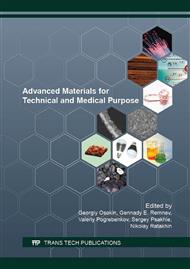p.93
p.99
p.105
p.112
p.117
p.123
p.133
p.137
p.143
Electrolytic Behavior Silver Microphases and Nanophases on the Graphite Electrode Surface
Abstract:
The stepwise mechanism of electrooxidation and reduction of silver nanophases and microphases is proposed on the graphite electrodes surface in alkaline medium. The electrochemical splitting of silver nanophases peak is observed on the anodic branch of the cyclic current-voltage curve. There is the shoulder at E = 0.2 V on the he anodic branch of cyclic current-voltage curve. The appearance of additional cathodic wave at E = -0.08 V is observed on the cathodic branch of the cyclic current-voltage curve that is caused by the reduction of silver nanoparticles. The additional cathode maximum is represented at 0.3 V on the cathodic branch of the cylic current-voltage curves of only silver nanophases. This effect is associated the catalytic process of decomposition of hydrogen peroxide on silver nanoparticles surface. The offset of the cathodic maxima of current-voltage curves of silver nanophases obtained with an excess of a reducing agent are observed to more negative potentials. There is a significant decrease of the all currents maxima compared to silver nanophases obtained with an equal molar ratio of reactants. These results may be connected with the formation of silver oxide monolayers in the different oxidation in the presence of large amounts a reducing agent. The excess of the reducing agent required for the preparation of silver nanoparticles leads to decrease of the cathodic maximum of silver nanoparticles
Info:
Periodical:
Pages:
117-122
Citation:
Online since:
September 2016
Authors:
Keywords:
Price:
Сopyright:
© 2016 Trans Tech Publications Ltd. All Rights Reserved
Share:
Citation:


